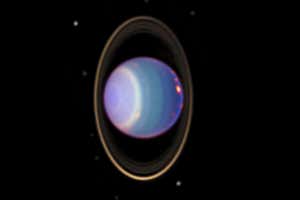Folks , I am doing a deeper dive on the subject of planetary magnetic fields , it's a tell-tale sign about the true nature of the planetary core , it's veritable calling card . I think this is the best approach to dislodge the solid planet theory , because a valid explanation for planetary magnetic field is the weakest link in the mainstream theory .
**Just sample this incredible fact - the Magnetic field of Uranus and Neptune is OFF-CENTER i.e. not even symmetrically aligned to the center of those planets !
My research indicates that if planets were solid , their geographic poles would invariably coincide with their magnetic poles . However , in reality , not a single planet has EVER been found , for which the magnetic poles exactly coincide with it's geographic poles . Why is this so ? What does this indicate about the internal structure of planets ?? The answer is that all planets are hollow :))
Uranus's crooked, messy magnetic field might open and shut daily
SPACE 23 June 2017
By Leah Crane

An open and shut case? Uranus seen in the infrared
Universal History Archive/Getty Images
Uranus has the weirdest magnetic field in our solar system, and it just got weirder. A new model suggests that the edge of its magnetic field bubble could be slamming open and shut every day.
Most of the planets in our solar system rotate around roughly similar axes, spinning in the same plane as their orbit. Their magnetic fields are aligned with these axes, with field lines emerging from the centres of the planets near their north and south poles and wrapping them in magnetospheres – protective bubbles of magnetism.
Uranus is not like most of the planets. It rotates on its side, tilted almost 98 degrees from the plane of its orbit around the sun. The axis of its magnetic field is tilted too, at a 59-degree angle from the rotational axis. The magnetic field is also off-centre, with the field lines emerging about a third of the way toward the south pole.
All of this makes Uranus’s magnetosphere a total mess. “As it is tumbling around, the magnetosphere’s orientation is changing in all sorts of directions,” says Carol Paty at the Georgia Institute of Technology in Atlanta.
To study the effects of this tumbling, Paty and her student Xin Cao created a model of the magnetosphere and its interactions with the solar wind, a stream of charged particles blown out by the sun.
Magnetic shield
The magnetosphere acts as a barrier to the solar wind: when the two are moving in the same direction, the solar wind slides off it like water off a duck’s back. But just as when water hits a duck’s feathers from the tail end, the duck gets wet, so when the solar wind blows toward Uranus at the right angle, the planet’s magnetic field lines up with the solar wind’s and lets some particles flow through.
This process, called magnetic reconnection, occurs occasionally near Earth’s poles, where the influx of particles from the solar wind can lead to intensified auroras. On Uranus, Paty and Cao found that it should happen every single day (roughly 17 Earth hours), switching the magnetosphere’s protection on and off. This could lead to an aurora there as well.
But it’s hard to know what exactly is going on at Uranus, since the only close-up observations we have are from 1986, when the Voyager 2 spacecraft whizzed past over the course of five days.
“We caught a glimpse of a mystery when we flew by,” says Paty. “We went inside Uranus’s magnetic field and suddenly it didn’t look like Earth or Jupiter or Saturn at all.” That brief snapshot isn’t much, but Paty’s model matches it perfectly.
“It’s great that it matches as well as it does with the one fly-by that we have of Uranus,” says George Hospodarsky at the University of Iowa. “But the real test would be sending an orbiter there and getting lots of data in different conditions and seeing if the model still matches.” NASA has plans in the works to send a new probe to Uranus in 2034, but no mission has been approved yet.
Ice giants
Paty hopes that as our tally of exoplanets grows, a greater understanding of Uranus will help us make inferences about those distant worlds, many of which are ice giants like Uranus and Neptune. Figuring out how their magnetic fields protect them (or not) from the stellar wind could be key to determining what their surfaces are like.
It may even lead to insights closer to home, by teaching us more about Earth’s relatively simple magnetic field.
“Looking at how Uranus’s complicated, strange magnetosphere works helps us understand how all the other systems work,” says Hospodarsky. “It’s sort of like doing an experiment one way and then turning it upside down and starting again. If it still works, your theories are good.”
Regards

/https://public-media.si-cdn.com/filer/ff/45/ff45bc38-2987-4b41-89ee-088db4c91876/jupiter_magnetic_field.png)